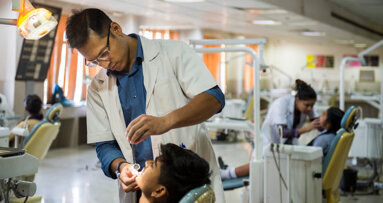Numerous studies have investigated prevalent personality types among dental students with a view to the predictive value for success in training. A new systematic review has found that the two predominant personality profiles of dental students in the US have changed over the past 50 years. The study involved the Myers-Briggs Type Indicator, which categorises personalities into 16 types according to the dimensions of extraversion/introversion, sensing/intuition, thinking/feeling and judging/perceiving. The study found that, while the extraversion–sensing–thinking–judging personality type remains prevalent, the extraversion–sensing–feeling–judging type has been replaced by the introversion–sensing–thinking–judging type. Dental Tribune International spoke with lead author Dr Chenshuang Li, assistant professor and clinical director of the orthodontic clinic at the School of Dental Medicine at the University of Pennsylvania in Philadelphia in the US, about the findings.
Dr Li, given this shift in predominant personality types among dental students, what factors do you believe have most significantly influenced these changes? Are there specific societal or educational trends that have contributed to this shift?
There are several potential influencing factors for these changes. The overall personality changes among different generations might be the major causes. Although every generation has been influenced by improvements in technology, the technological development in the past decades has been dramatic. Subsequently, the ways that the younger generations use to obtain information and knowledge are completely different from those of the older generations. This could also significantly influence how dental students—and the general population—interact with each other. Just think about the changes from handwriting letters to typing emails, from making phone calls to messaging on social media!
How do the changes in predominant personality types affect the clinical performance of dental students and their interaction with patients? Have these changes led to modifications in clinical training and evaluation methods?
Research in 1997 found that, in the US, introverted students had a significantly higher performance on National Board Dental Examinations Parts I and II, but demonstrated a progressively lower class rank over the four-year period and were more likely to experience major academic difficulties compared with extroverted students. However, in South Korea in 2009, no difference was found between extroverted versus introverted dental students on their grade point averages in dental school. In addition, in 1990, research found that among the senior dental students in the US, introverted and judging learners tended to communicate more effectively than did extroverted and perceiving learners.
Based on the conflicting information provided by previous studies, we cannot make any conclusion regarding whether extroversion is better or worse than introversion in clinical performance and patient interactions. However, since the available studies on this topic do not necessarily represent the current dental school environments, the papers having been published 15–35 years ago, and a change from extroverted to more introverted is one of the major findings we observed in our study, we recommend that how dental students’ personalities influence their clinical performance in current dental educational settings needs to be evaluated. We hope that our study will draw the attention of dental educators worldwide for further improvements in teaching strategies and student support services.
“Although every generation has been influenced by improvements in technology, the technological development in the past decades has been dramatic.”
The study noted variations as well as similarities in personality types among dental students from different countries. How might cultural factors influence these personality differences, and what strategies could dental schools implement to accommodate these diverse personality profiles in their curricula?
Like social circumstances influence personality, so too do cultural factors. In addition, we must acknowledge that different countries have different educational systems. For example, some countries have dental school training after students graduate from high school, but some countries don’t allow students to enter dental school until they have obtained a bachelor’s or higher degree. With more and more students choosing to study abroad, dental educators are facing students from diverse backgrounds. Thus, providing an inclusive and equal educational environment is important. In addition, the patients we are treating now also have more diverse backgrounds than previously; thus, how to train our students to engage with patients appropriately is also an important topic that needs to be evaluated.
How do the personality types identified correlate with preferred learning styles among dental students? Are there any adjustments that dental educators should make to their teaching methodologies to better align with the changing personality profiles?
As there are no intensive studies on the efficiency of different teaching methods for students with each personal type, we cannot make suggestions regarding one teaching method over another for the current dental student population. However, we hope that our findings will bring awareness in the dental educational field to this aspect and will serve as a foundation for further improvements in teaching strategies and student support services.
Topics:
Tags:
LONDON, UK: After its recent landslide victory in the UK general election held on 4 July, the new Labour government has placed dentistry high on its list of...
DUBLIN, Ireland: Many individuals in Ireland who have difficulty in getting a National Health Service (NHS) dental appointment today will remember a time ...
NAGPUR, India: The sheer number of dental colleges in India makes the country a global powerhouse in dental education, and efforts are underway to ensure ...
PLYMOUTH, UK: The ramifications of sharps injuries within a clinical treatment setting extend beyond the immediate physical harm, potentially inducing ...
JEDDAH, Saudi Arabia: A staggering 1.5 billion people are estimated to suffer from some level of hearing loss globally according to the World Health ...
Live webinar
Wed. 14 January 2026
12:00 PM EST (New York)
Dr. Théo Laplane, Dr. Robert Gottlander DDS
Live webinar
Fri. 16 January 2026
12:00 PM EST (New York)
Live webinar
Mon. 19 January 2026
1:00 PM EST (New York)
Philipp Kopp, Michael Seeber
Live webinar
Thu. 22 January 2026
9:00 AM EST (New York)
Prof. Judith Jones D.D.S; M.P.H., Prof. Kakuhiro Fukai D.D.S., Ph.D, Dr. Bathsheba (Bethy) Turton
Live webinar
Thu. 22 January 2026
2:00 PM EST (New York)
Dr. Nicola M. Grande DDS, PhD
Live webinar
Wed. 28 January 2026
8:00 AM EST (New York)
Live webinar
Wed. 28 January 2026
11:00 AM EST (New York)
Prof. Dr. Jan-Frederik Güth



 Austria / Österreich
Austria / Österreich
 Bosnia and Herzegovina / Босна и Херцеговина
Bosnia and Herzegovina / Босна и Херцеговина
 Bulgaria / България
Bulgaria / България
 Croatia / Hrvatska
Croatia / Hrvatska
 Czech Republic & Slovakia / Česká republika & Slovensko
Czech Republic & Slovakia / Česká republika & Slovensko
 France / France
France / France
 Germany / Deutschland
Germany / Deutschland
 Greece / ΕΛΛΑΔΑ
Greece / ΕΛΛΑΔΑ
 Hungary / Hungary
Hungary / Hungary
 Italy / Italia
Italy / Italia
 Netherlands / Nederland
Netherlands / Nederland
 Nordic / Nordic
Nordic / Nordic
 Poland / Polska
Poland / Polska
 Portugal / Portugal
Portugal / Portugal
 Romania & Moldova / România & Moldova
Romania & Moldova / România & Moldova
 Slovenia / Slovenija
Slovenia / Slovenija
 Serbia & Montenegro / Србија и Црна Гора
Serbia & Montenegro / Србија и Црна Гора
 Spain / España
Spain / España
 Switzerland / Schweiz
Switzerland / Schweiz
 Turkey / Türkiye
Turkey / Türkiye
 UK & Ireland / UK & Ireland
UK & Ireland / UK & Ireland
 International / International
International / International
 Brazil / Brasil
Brazil / Brasil
 Canada / Canada
Canada / Canada
 Latin America / Latinoamérica
Latin America / Latinoamérica
 China / 中国
China / 中国
 India / भारत गणराज्य
India / भारत गणराज्य
 Pakistan / Pākistān
Pakistan / Pākistān
 Vietnam / Việt Nam
Vietnam / Việt Nam
 ASEAN / ASEAN
ASEAN / ASEAN
 Israel / מְדִינַת יִשְׂרָאֵל
Israel / מְדִינַת יִשְׂרָאֵל
 Algeria, Morocco & Tunisia / الجزائر والمغرب وتونس
Algeria, Morocco & Tunisia / الجزائر والمغرب وتونس
 Middle East / Middle East
Middle East / Middle East
























































To post a reply please login or register